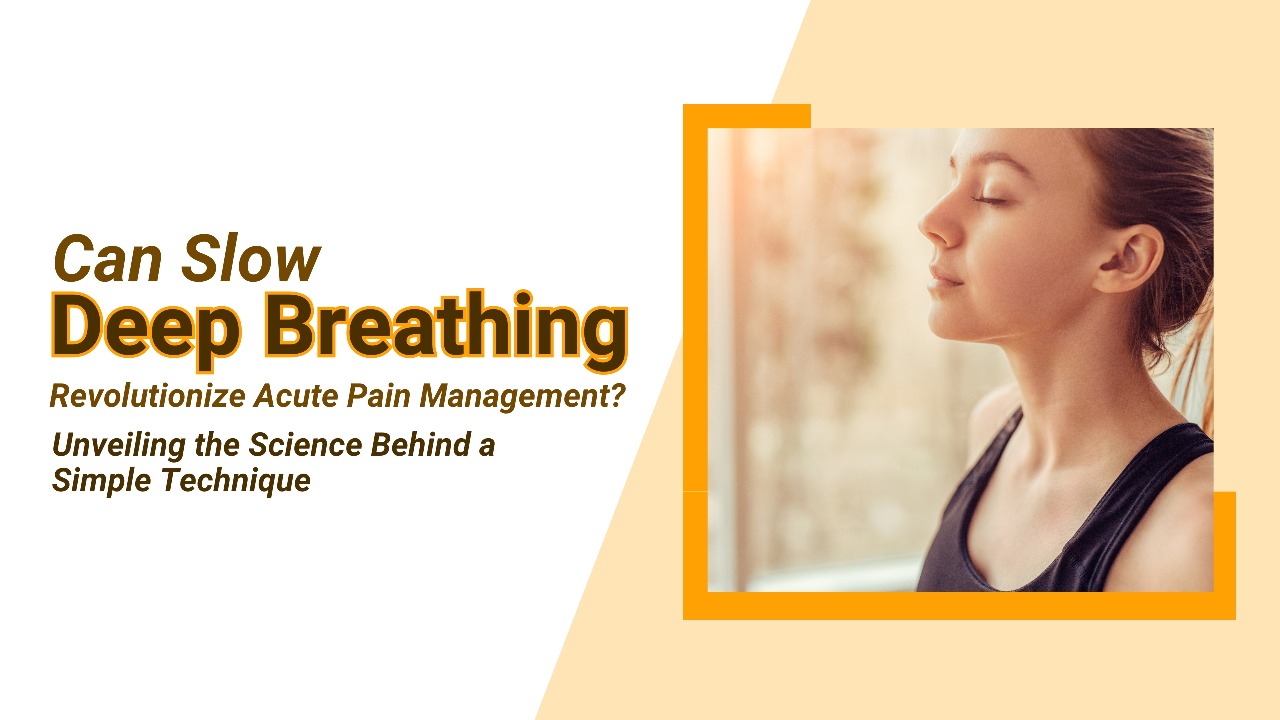Imagine a world where a simple, cost-free technique like slow deep breathing (SDB) could transform how we manage acute pain—without relying solely on medications. A groundbreaking systematic review and meta-analysis published in the Journal of Evidence-Based Integrative Medicine(2022) explores this very possibility. Titled “Effects of Slow Deep Breathing on Acute Clinical Pain in Adults,” this study dives into the potential of SDB as a nonpharmacological approach to alleviate acute pain. Let’s unpack the science, implications, and mind-blowing potential of this ancient practice in modern medicine.
A Deep Dive into Slow Deep Breathing!
Led by Amira E. Joseph, MD, and a team of researchers from the Mayo Clinic, this systematic review and meta-analysis sifted through 11,968 studies to identify seven randomized controlled trials (RCTs) involving 847 participants. These trials focused on adults experiencing acute pain from three distinct sources: burn pain, obstetric labor pain, and postoperative pain. The primary goal? To determine if SDB could reduce pain intensity compared to standard care. Secondary aims explored its impact on physical and emotional functioning.
The findings are nothing short of intriguing. The meta-analysis revealed that SDB was associated with a statistically significant reduction in acute pain intensity (standardized mean difference [SMD] -0.68, 95% CI -1.19 to -0.18). However, the results came with a catch: high heterogeneity (I² = 90%), suggesting variability in the effect across different pain types and study designs.
Let’s break down what this means and why it’s a game-changer!
The Power of Breath: How Slow Breathing Works?
Slow deep breathing, a cornerstone of practices like yoga and mindfulness, involves controlled, deliberate breaths—often at a reduced frequency (e.g., 6 breaths per minute) with prolonged inhalation and exhalation phases. But how does something as simple as breathing ease pain? The study points to several potential mechanisms:
- Cardiovascular Connection: The baroreceptor system, which monitors blood pressure and heart rate changes during breathing, may play a role. Signals from baroreceptors in the carotid sinuses and heart travel via the vagus nerve to the brain’s nucleus of the solitary tract (NST). From there, connections to limbic and forebrain regions involved in pain processing could modulate pain perception.
- Brain Modulation: SDB activates brain areas like the ventral-lateral prefrontal and anterior cingulate cortices, which are linked to pain modulation, while reducing activity in the thalamus, a key pain relay center. This mirrors mechanisms seen in mindfulness meditation, suggesting SDB could alter how the brain appraises pain.
- Anxiety Reduction: Particularly relevant for burn patients, SDB may reduce pain-related anxiety, a known amplifier of pain perception. By fostering a relaxed state, SDB could act as a distraction, lowering the emotional toll of pain.
Interestingly, the study found that SDB’s pain-relieving effects are not primarily driven by the endogenous opioid system or cardiovascular changes, pointing to other factors like attention, emotion, and behavioral modulation. This opens a Pandora’s box of possibilities for understanding how our breath influences our body’s pain response.
Burn Pain: A Standout Success!
The most striking finding came from subgroup analyses. SDB showed a dramatic effect on burn pain, with a pooled SMD of -2.24 (95% CI -3.49 to -0.98), indicating a substantial reduction in pain intensity during dressing changes. This is a big deal—burn dressing changes are notoriously painful and anxiety-inducing, often requiring heavy analgesia. The fact that a non-invasive technique like SDB could make a dent here is revolutionary.
In contrast, the effects on obstetric labor pain and postoperative pain were less conclusive, with no significant differences compared to control groups (SMD -0.19 and -0.04, respectively). This variability suggests that SDB’s efficacy may depend on the type of pain, the context of its application, and how the intervention is delivered.
Why This Matters: A Paradigm Shift in Pain Management
The implications of this study are profound. Acute pain, whether from burns, surgery, or childbirth, is a universal human experience, often managed with opioids or other medications that carry risks of side effects and dependency. SDB offers a safe, accessible, and cost-effective alternative or adjunct that empowers patients to take control of their pain. Imagine burn patients finding relief during dressing changes or postoperative patients recovering with less reliance on drugs—all through the power of their breath.
Moreover, SDB’s potential to reduce pain-related anxiety could have ripple effects on emotional and physical functioning, improving overall recovery. For healthcare systems strained by costs and resources, integrating SDB into clinical practice could be a low-hanging fruit with high impact.
Let’s Do It : A Simple Guide
Curious about trying SDB yourself or recommending it to others? Here’s a basic protocol inspired by the study’s descriptions:
- Find a Comfortable Position: Sit or lie down in a quiet space.
- Inhale Slowly: Breathe in through your nose for 4-5 seconds, counting silently.
- Exhale Gradually: Breathe out through pursed lips for 4-5 seconds.
- Pause (Optional): Hold your breath for 1-2 seconds after exhaling.
- Repeat: Aim for 6-10 breaths per minute, focusing on deep, controlled breaths.
For acute pain episodes, like during labor contractions or burn dressing changes, time the breathing with the pain event for maximum effect. Always consult a healthcare provider before incorporating SDB into your pain management plan.
The Future of SDB: Breathing Toward a Pain-Free World!
This study is a clarion call for more research to unlock SDB’s full potential. By refining how we deliver and study this technique, we could see SDB become a standard tool in pain management protocols, from emergency rooms to outpatient clinics. Its simplicity is its strength—anyone, anywhere, can learn to breathe their way to relief.
As we stand on the cusp of a nonpharmacological revolution, the message is clear:“ sometimes, the most powerful medicine is as close as your next breath.”
References:
Joseph AE, Moman RN, Barman RA, Kleppel DJ, Eberhart ND, Gerberi DJ, Murad MH, Hooten WM. Effects of Slow Deep Breathing on Acute Clinical Pain in Adults: A Systematic Review and Meta-Analysis of Randomized Controlled Trials. J Evid Based Integr Med. 2022 Jan-Dec;27:2515690X221078006. doi: 10.1177/2515690X221078006. PMID: 35225720; PMCID: PMC8891889.
Written by -Dr Sathyachandran K


